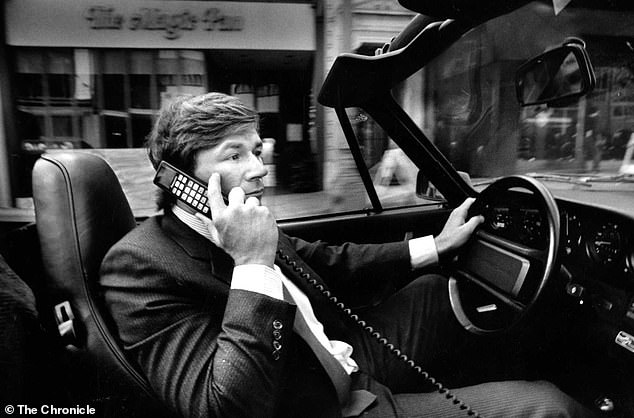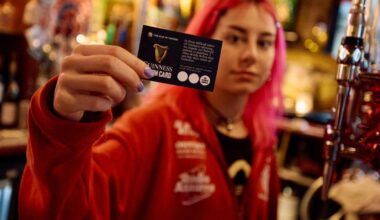We’re entering an era of driverless cars, cloud-connected motoring and smart function features.
And as this automotive advancement happens, old car tech and much-loved features of decades gone are becoming faint memories.
But if you’re like us, and you have a hankering for some of the best car features of retro years, then you’ll enjoy a walk down motoring memory lane.
Here’s 10 of the most iconic car features that are will soon belong to automotive history books – with the CD player most recently joining the list.

Dial up from the dashboard – car phones were the chicest business luxury in cars of the 20th century. Which other features are missed ?
1. Manual windows

Do you remember just years ago when we all had to use actual muscle strength to roll windows up and down?
Back in the good old days, you’d wind your window up and burn calories as a bonus.
Frantically winding windows up and down when the weather changed was a real case of ‘put your back into it’.
While most people can remember cars with manual windows as the norm, the invention of power windows actually goes back a lot further than you’d think.
In 1941 the Packard 180 became the first car to have power windows and used a hydro-electric system to operate them – technology that was actually invented for WWII to lower and raise army vehicle roofs.
From then on General Motors, Ford and and Cadillac were amongst the car makers who started rolling out the feature during the 70s, 80s and 90s.
Now we live in a world where we have one-touch windows, that go down or up automatically.
But for anyone opposed to electronic progress, a few cars are still clinging on to that crank-handle window tech: in the US the Jeep Wrangler base trim comes with manual windows, while in the UK the Dacia Sandero still has manual windows.
2. Analogue driver dials

This Renault from 2014 had the driver dials most of us are used to from recent analogue times
A black plastic background, white numbers and orange needles – driver dials used to be both analogue and very clear.
And if you wanted to know how many miles a trip was, you’d have to do mental maths with an old school odometer.
Today driver dials are digital, with digital instrument cluster ranging massively in design, shape and setup.
Some new cars have a slim screen for the driver that shows speed and little else for a minimalistic look, while others show everything from trip data to media, and can be configured to different themes and setups.
3. Fresh air vents

Before the days of air con, classic cars had vents that let air in… and that was your lot
Classic car owners who’ve ever had an old Land Rover or Citroen 2CV will know that air con used to be physical vents that you just opened or closed to let air in.
If you wanted ‘cool’ air you’d have to open the vent and if you were cold you’d best keep the vents closed and wear a very warm coat. Blankets for passengers made you more popular too.
While we love a bit of car nostalgia, we are forever grateful for the invention of air con and heating.
4. Colour-pop interiors
In the current climate of smart tech cars and EVs, minimalistic Scandi interiors are de rigueur.
Almost every new model comes with a clean, sparse interior of neutral blacks, greys, whites and beige.
Occasionally there might be something as bold as red sports seats, or contrast stitching, but for colour that’s pretty much your lot.

The Renault 5 interior was one of the most colourful setups any motorist will ever see. These days no manufacturer would offer such interior options, instead opting for much more muted greys, blacks, whites and creams
But turn back the clock to the 1980s and 1990s, and car interiors and exteriors could be found in every shade of the rainbow.
In the ’80s pattern cloth seating became a thing (who remembers the G-Wagon mustard chequered seats?) while the Mercedes 560 SEC had an interior of red on red on red on red on red.
Velour seats were, if not practical, also very in.
Interior colourways ranged from cinnamon to green, and there was seemingly no limit to the customisation or personality you could add to your car’s appearance.
5. Pop-up headlights

Social media is awash with Miata owners showing off their pop-up headlights
Safety regulations and European design laws have all but killed off pop-up headlights, but there are some retro and classic car owners who are lucky enough to still be driving around in cars with these fabulous headlights.
Miata owners are having a moment on social media.
For anyone who’s missed it, the viral video of Miata drivers greeting each other in traffic by popping their headlights up and down is worth a nostalgic view – it’s the Landy wave for MK1 MX-5s.
And we like to see pop-up headlights – which were such a prominent feature of 80s and 90s sports cars and supercars including the Porsche 944 and Lamborghini Countach – getting the appreciation they deserve.

In one of the most famous scenes in Wolf of Wall Street, Jordan Belfort played by Leonardo Di Caprio tries to climb into his Countach and drive off while off his face on quaaludes

The pop-up headlights were one of the features destroyed on the Countach used for filming
6. Car phones
A lot of car nostalgia dates back to the 80s and 90s, and car phones are no exception.
Cast your mind back to before the dawn of mobile phones and Apple CarPlay and the last few decades of the 20th century saw luxury cars equipped with car phones.
The feature became popular in the 1970s, and died out in the 90s, but the first car phone crossed the Atlantic to arrive in the UK as early as 1959.
Motorola had previously introduced the car phone in America in 1956, using radio technology to connect a car phone to landlines across the US.
The first ever car phone call connected Postmaster General Reginald Bevins in Lymm, Cheshire to motor manufacturer Lord Rootes in London in 1959.
The BBC captured the historic moment, which allowed people to subscribe to South Lancashire Radio Phone Service. The drawback was that only six calls could be made at any one time.
7. Manual handbrakes

Manual handbrakes are now a thing of the past, with almost no modern cars having them
One of my youngest car memories is of a family friend parking her car on the hill outside our house, only for someone to spot it rolling past the front window a few minutes later and her frantically running after it before it gathered pace.

These days parking brakes are flicked on with a touch of a button
This Mr Bean moment was not so unusual in a time when every car had a manual handbrake. If you didn’t pull the handbrake properly, then your car could very easily end up nowhere near where you left it.
Manual handbrakes were a fundamental part of learning to drive (hill starts don’t have the same terror anymore) and a good gauge of upper body strength.
In this new age of automatic parking buttons there’s none of the frustration of driving a car after someone else has pulled the handbrake on so hard it takes you two hands and a lot of might to release it.
8. Radio station presets
With the news that Subaru has axed the in-car CD player once and for all, after removing the device from its Forester SUV as of 2024, we’re harking back to the time of manual radio station presets.
While radio, unlike the CD player, is still very much a feature of modern cars, these days all new cars come with digital radio presets.
But it wasn’t very long ago when you had to program your favourite radio stations yourself, and you would only have a maximum of around six preset buttons to set.

Scrolling through radio stations to preset your car radio to have all your favourites stored and easily accessible at the touch of a button seems like a distant memory in this digital radio age
Not only did this involve scrolling through static until you reached the best tuning or your area, if also meant having to grin and bear an out-of-tune radio whenever you went in and out of a service area.
And that was all part of the fun that came after the family ‘discussions’ on how to divide up the presets fairly.
9. Switches/ physical buttons

The newly released MG ZS second generation has a multitude of easy to use buttons to accompany the touchscreen. Physical buttons are back to much demand
We’ve included this one because it’s having a bit of a full-circle moment, and we couldn’t be happier about it.
While the days of dash switches might be over – although the possibility of this retro resurgence shouldn’t be entirely discounted – the move back to physical buttons is in full swing.
We’ve had years of car infotainment screens becoming bigger, higher definition, wraparound and of course touchscreen, but now buttons are back and it looks like they might be here to stay.
This is partly due to popular demand, and partly because there are increasingly safety fears that big touchscreens are dangerous and distracting.
From cheaper brands like the Dacia and MG, to luxury brands like Mercedes across the board manufacturers are making sure to include buttons.
10. Cigarette lighters

Banning smoking in cars with anyone under 18 present was a much needed move to improve health. Now cigarette lighter have morphed into 12V sockets to plug electronics into

The ban on smoking in cars if anyone is under 18 was a welcomed move. Manufacturers banding together to stop selling cars with cigarette lighters and ash trays was a responsible change by the industry. These days cigarette lighters are replaced with 12V sockets for electronics – a modern update for the better
Last but not least, cigarette lighters and ash trays.
We aren’t nostalgic about this feature: banning smoking in cars with anyone under 18 present was a much needed move to improve health.
But for the history books it’s worth mentioning this feature that was so prevalent before the mid 1990s. Especially because these days you still have what looks like a cigarette lighter but it is in fact just a 12V power outlet.
In 1994 Chrysler stopped offering cars with ashtrays and then all other manufacturers grouped together to stop smoking in cars.
It was Hyundai who decided to use the feature as a 12V power source instead.
Now this feature has metamorphosed across the industry to be a safe and useful way to charge devices.
Some links in this article may be affiliate links. If you click on them we may earn a small commission. That helps us fund This Is Money, and keep it free to use. We do not write articles to promote products. We do not allow any commercial relationship to affect our editorial independence.
Source link






